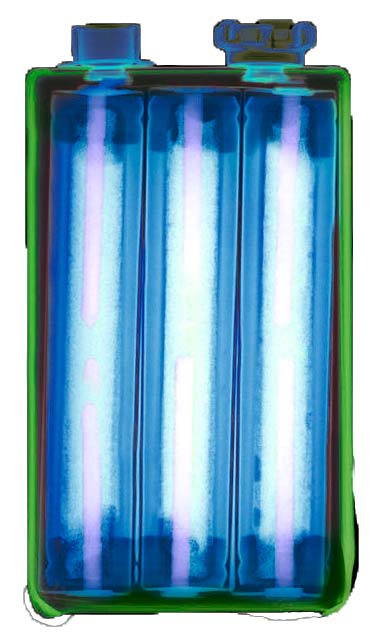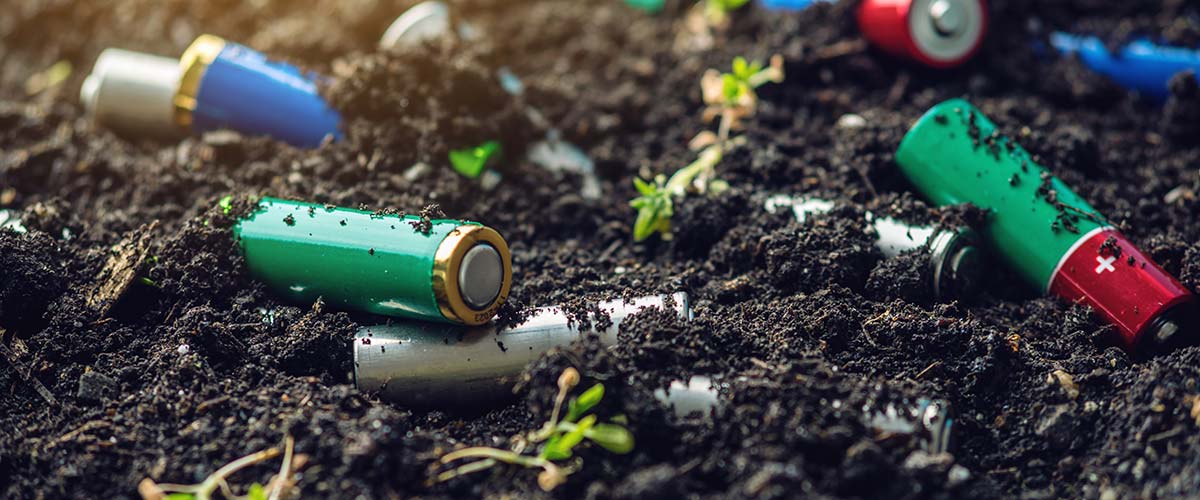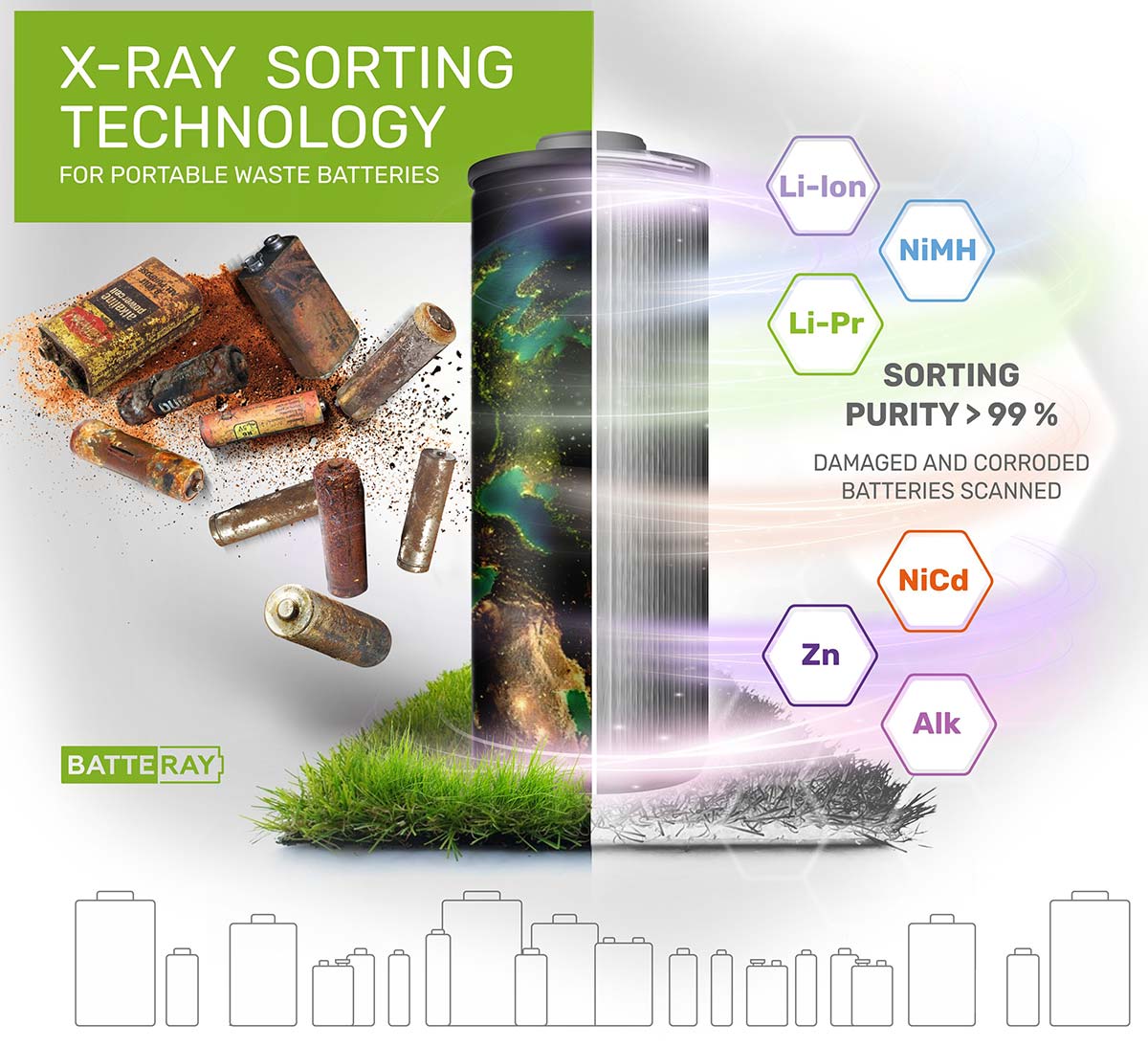Battery X-ray Sorting
Global Responsibility
Disposal or recycling of used portable batteries is becoming an increasingly global problem with the increasing consumption of batteries. More and more public attention is directed to the proper collection of waste, storage, correct sorting, and the development or modernization of recycling methods to realize the possibility of recycling materials and minimize the amount of recycled waste, due to which harmful substances can enter the soil, water, atmosphere and, of course, the human body.

According to the Extended Producer Responsibility system implemented in Europe, each battery manufacturer or supplier pays a fee to the state fund to ensure the proper recycling of batteries. This money goes to non-profit regulatory organizations that mediate between the manufacturer and the recycling companies and organize the process of separate waste collection and recycling. Many recycling companies do not tackle the sorting issue themselves and do not always accept a mixed stream of batteries for recycling, since the cost of recycling one sorted type of batteries is 4 times lower than the cost of recycling a mixed stream.
Our technology used at the sorting stage will increase the efficiency of the process as a whole - increasing the number of recycled batteries and reducing the cost of recycling, which means reducing the costs of all stages.
Moreover, we all know that the quality of the final product of processing directly depends on the quality of the sorting - different fractions of substances with different fields of application are obtained from different types of batteries. It is obvious that the presence of heavy metals in fertilizers defeats the purpose of using them for agricultural benefit. Same as the presence of impurities in metals makes the metallurgical processing process more labor-intensive and difficult to implement. And we should bear in mind that the higher purity of sorting dramatically reduces the risk of emergencies, such as explosions and fires in lithium battery recycling plants.
Sorting Methods
There are several methods of sorting batteries currently in the world, depending on the major task they address as to quickly and with the highest possible accuracy divide the mixture of used batteries into types according to their internal chemical composition: manual method, optical method, sorting by weight and electrical conductivity, magnetic sorting.
There are a large number of different types of batteries and accumulators currently on the market. All of them belong to the category of hazardous solid household waste because depending on the type of their electrochemical cells, they contain highly toxic heavy metals such as mercury, cadmium or lead in various concentrations.
According to the literature, used batteries make up to 40% of all toxic substances that enter the environment along with household waste.
Some batteries and accumulators contain expensive metals such as silver, nickel, cadmium or zinc in concentrations that are much higher than the concentration of these metals in natural ores.
Global Recycling Problem
The production of batteries and accumulators is constantly growing. In order to exclude toxic heavy metals from entering the environment with household waste, as well as due to the expediency of using raw materials from used batteries or accumulators in the metallurgical industry, the issue of collection, sorting and recycling of batteries and accumulators relevant

In European countries, battery recycling issues have been dealt with for a long time, battery collection rates are constantly increasing and in 2019 they amount to about 45% of the total number of batteries and accumulators consumed in the European Union.
In most industrialized countries, there is a developed infrastructure for separate waste collection, and collection points for used batteries are organized in public places. Thus, in the collection containers there is a mixture of waste batteries and accumulators with various types of electrochemical cells.
For the reuse of valuable metals and substances in industry, a high degree of purity of the sample of batteries to be recycled (over 95%) is essential, Therefore, old batteries and accumulators that have fallen into collection containers should be sorted according to their electrolyte type.
It should be noted that today no automatic battery sorting process is accurate enough to be used on an industrial scale. In particular, for mixtures of used batteries and/or batteries collected in a non-selective manner, the above sorting is still done manually, with maximum purity levels reaching 80%
LINEV Group X-ray Battery Sorting Solution
Since 2018, the staff LINEV Group has carried out a number of studies in order to substantiate the fundamental possibility of solving the problem of identifying and sorting various types of used batteries using X-ray technology, as well as choosing the main components and optimal operating modes of the installation. Based on the internal structure of the batteries, each individual type has characteristic regions that are automatically detected on an X-ray.
What is the unicity and main advantage of the X-ray technology? We can state boldly that our technology sees right through the batteries. What problems does this solve? If the battery is missing a label, marking, or it is rusted, our system will still correctly identify the type of battery.
Also, counterfeit batteries from unscrupulous manufacturers are often found on the world market - the composition of the battery does not correspond to what is indicated on the label. Neither human eyes, nor any optical system will be able to recognize the discrepancy, and this will become the very unknown sorting error that can lead to unpleasant consequences. X-ray technology does not look at the label - if the recognition algorithm sees that the battery is based on NiCd, it will not send it to the group with metal hydride, no matter what the marking says.

To achieve the best accuracy in dividing batteries and accumulators into types, the process of identifying and classifying the characteristics of batteries on X-ray images was worked out, and special algorithms were developed that can recognize and sort into five types of all household cylindrical batteries of standard sizes, as we as 9V.
The sorting process is fully automated thus eliminating the influence of the human factor, and there is no longer any need to involve manual human labor in such a process that is harmful and hazardous to health.
The combination of a design solution for a conveyor system and a developed algorithm for battery recognition based on machine vision and artificial intelligence allows for sorting batteries at high speed and with very high accuracy. For the most popular types, alkaline and saline, the sorting accuracy is> 99%.
The standard sorting chart includes the most popular and frequently encountered types and sizes of batteries: Zinc-carbon (salt), alkaline, nickel-metal hydride, nickel-cadmium, lithium. However, the user has the option to add his own standard sizes; for this, the system uses a self-learning module.
BATTERAY - The ideas and innovations implemented
The commercial solution of our product - the [LV] BATTERAY system - has, in our opinion, the following important advantages:- The batteries feeding hopper can be tailored to various sizes, depending on the throughput of the processing line at the enterprise. We can also modify the orientation conveyor for the required number of types of batteries.
- We have designed a special conveyor for cleaning small debris - as a result, clean single batteries are scanned, all small debris, electrolyte dust, battery debris and small tablet batteries are eliminated, the sorting results are not distorted, the fractions of substances are cleaner.
- It is also possible to clean the entire system apart from the scanning part with a high-pressure washer thus making sure the system is always kept clean.
- There is no need to worry about the danger of ionizing radiation, the System fully protects the operator from the effects of ionizing radiation and is designed in accordance with European safety standards.
- Our system is ready to work even in extreme weather conditions even in hot and humid countries.
The use of X-ray technology in battery testing is not limited to sorting portable batteries. As the number of electric vehicles grows, so does the number of produced batteries for them. Our technology simplifies the process of product quality control and makes it more reliable.
Our team is ready for new unknown to us problems and tasks in the field of production and processing of batteries.


